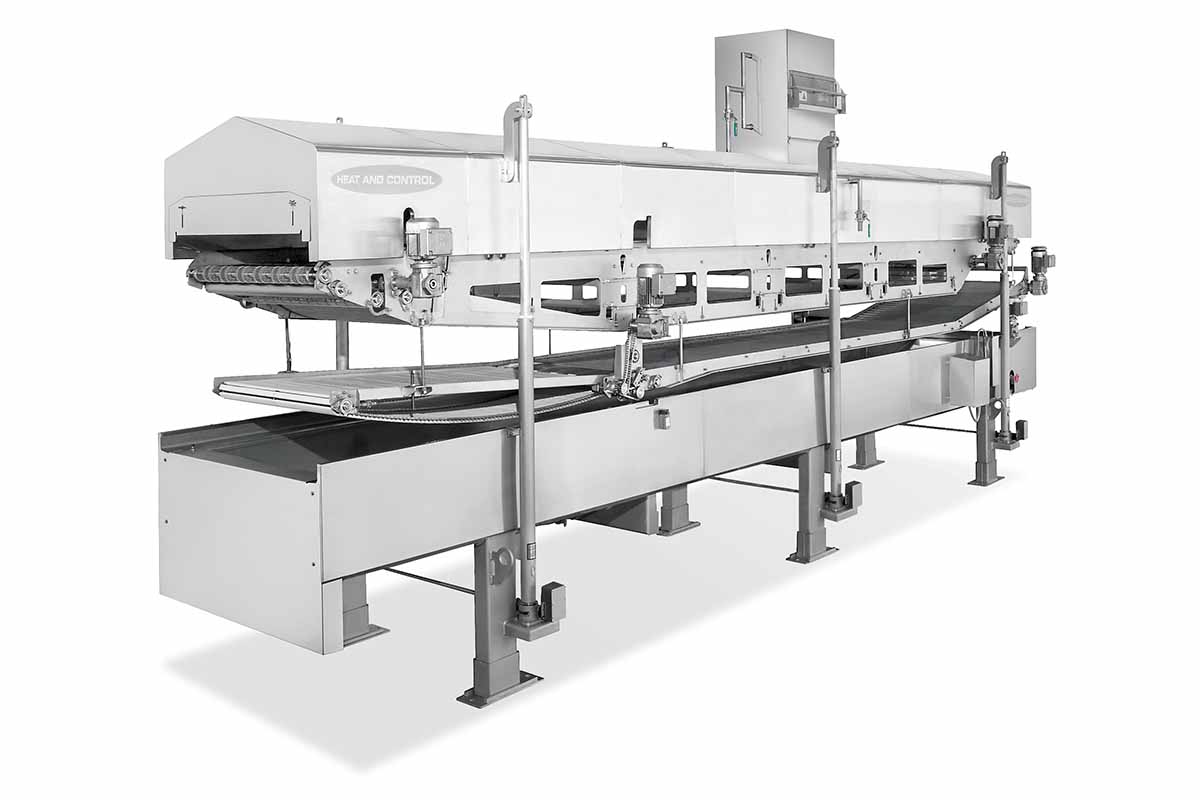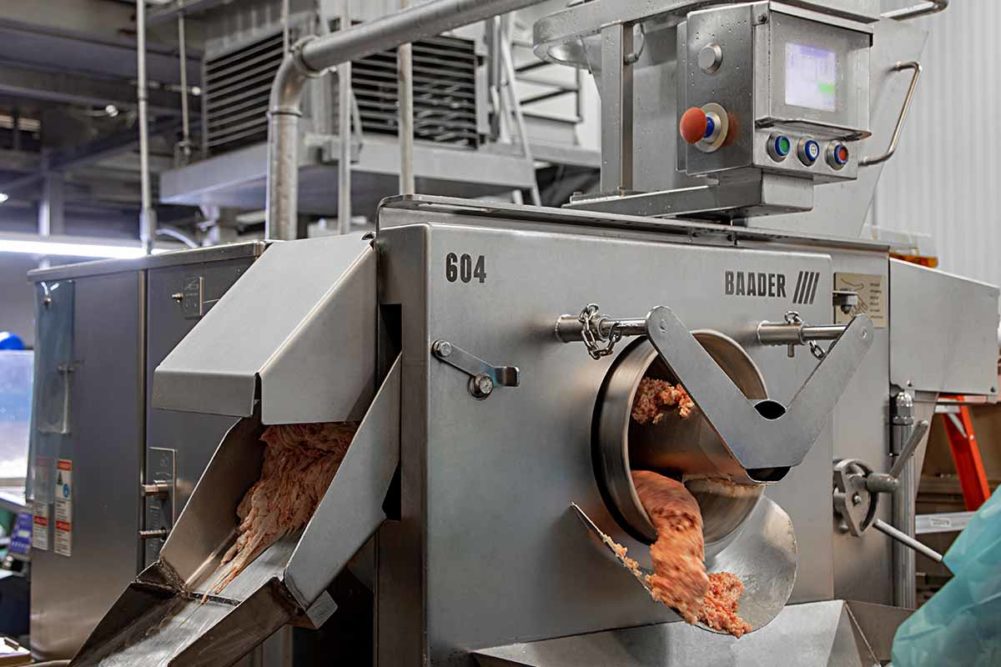When it comes to chicken nugget processing, there are several new advances in blending, grinding, forming and bagging/boxing taking place throughout the industry. Across the board, improvements have been made to increase production capacity and provide multiple breading options.
“Production capacities increase each year and customers are continuing to improve their processes to reduce waste,” said Jacob Deehr, product manager of coating and frying for Sandusky, Ohio-based JBT Corp. “We are also seeing a need for Prolink line control to help operators with recipe control. Our Prolink line control offers operators repeatable preset settings for belt speeds, progressive stops and frying temperatures.”
Ken McCaffrey, refiner product specialist for Baader in Kansas City, Kan., notes the impact of inflation with increases in prices has impacted suppliers.
“Processors must consistently deliver top-tier products to warrant the higher prices consumers face,” he said. “As processing costs increase, so do consumer prices, but customers expect the same or improved value. As inflation increases, consumers become increasingly price-sensitive, prioritizing the best value while still demanding quality.”
Doug Kozenski, processing industry manager, Heat and Control, Hayward, Calif., noted there has been an influx of automation of the equipment to lessen labor demands.
“A key area of this is the sanitation process,” he said. “Heat and Control recently has been providing fully automated CIP systems on many fryers and ovens. This system automatically fills the system with water, adds and maintains the sanitation chemicals, drains the system, and rinses the system. This level of automation greatly reduces the labor required for the sanitation process.”
Another trend has centered around improved safety. As the industry sees additional turnover in operators, finding less experienced operators on the processing line is becoming more common. Safety systems have been advanced to make them more “bulletproof” in their ability to protect operators from mistakes.
“In frying operations, a significant hazard is the potential to introduce water into hot oil which creates a hazardous spray, or worse,” Kozenski said. “This problem is exacerbated as additional filtration systems and accessories are added to a fryer creating potential places for water to collect or to remain in the system. Fryer safety systems have been advancing to address this hazard.”
 Heat and Control has automated the sanitation of fryers and ovens by implementing clean-in-place technology. (Source: Heat and Control)
Heat and Control has automated the sanitation of fryers and ovens by implementing clean-in-place technology. (Source: Heat and Control)Standing out
Wayne-Sanderson Farms operates three prepared foods facilities that produce a host of fully cooked and partially cooked products, offering both formed options for chicken nuggets, as well as whole muscle options. These can be breaded and par fried, breaded and fully cooked as well as grilled and sold at retail.
“Wayne-Sanderson Farms provides unique products such as its boneless Crispy Fliers which are known for the crispy crunch of every bite,” said Frank Singleton, a spokesman for the company. “We have equipment that increases our production capacity for formed product in order to meet customer demand.”
On the plant level, the company installed a new blend/grind system recently which increases the overall throughput capabilities on the forming line.
Heat and Control manufactures a wide range of equipment for chicken nugget processing such as its SureCoat line of batter and breading equipment, frying systems to either par-fry or fully fry the product, oven systems to fully cook the product if par-fried, product handling after freezing, and complete packaging and inspection equipment.
“We also offer our AirFry System; this system replaces the traditional submersion oil fry with a low volume spray application of oil to the breaded product that then passes through our AirForce impingement oven to be either par-cooked or fully cooked,” Kozenski said. “This process reduces oil content of the product significantly and, in most cases, very closely matches the traditional fried product color and texture characteristics.”
JBT offers full line solutions for both breaded and batter fried chicken nuggets.
“Sam Stein helped create the conveyorized batter and breading equipment we all use today,” Deehr said. “In addition to our equipment, we have a highly skilled applications team and service team that can assist customers with their applications needs, equipment optimizations and training. On top of our support, we also have our food processing technology center which helps customers develop new products or validate current processes without being interrupted by the daily activities at the plants.”
The company also offers a batter measuring device, the Stein cup, which most of the industry uses for quick repeatable viscosity measurements.
Baader provides white meat intended to produce chicken nuggets and Baader refiners offer various methods for feeding products into the machine to enhance plant efficiency and achieve the best possible yield.
“Deboned trimmings and carcasses from our automated breast debone machines are subsequently processed by Baader refiners,” McCaffrey said. “The resulting product maintains a solid white meat texture suitable for chicken nugget processing. Furthermore, customers have the flexibility to select different drum hole sizes to suit various product applications. For example, using 2 mm-holes results in a finer mince, whereas 5 mm-holes yield a thicker texture.”
 Wayne-Sanderson Farms produces nuggets in a variety of formats for retail customers. (Source: Wayne-Sanderson Farms)
Wayne-Sanderson Farms produces nuggets in a variety of formats for retail customers. (Source: Wayne-Sanderson Farms)Environmental impact
A prominent current trend is reducing the overall environmental impact and carbon footprint.
For instance, Heat and Control continually works to improve the efficiency of its equipment, with the iHX high efficiency heat exchanger as one example.
“We also utilize means to capture and to use waste heat from gas fired heat exchangers to bring efficiencies possibly to the low 90% range,” Kozenski said. “There has also been an increased interest in electric heating of the cooking oil. While electric heating has traditionally been very expensive for processors, current and future regulations may force processors into electric heating.”
That’s why Heat and Control has been exploring multiple electric platforms for different types of heating, including resistive, induction, and impedance heating.
“We have found that all are viable options, and that the factory location is the key factor to determine which energy source is the best option,” Kozenski said. “We are finding an absence of infrastructure in many locations needed to support the electrical energy demand to operate large frying systems. The infrastructure will require a significant investment by the company to effectively employ electric heating equipment.”
Heat and Control is also exploring alternative fuel options, such as hydrogen, where water is the result of the combustion process.
Overcoming challenges
Customers today face challenges with staffing and turnover so it’s important the solutions focus on solving these issues.
For instance, JBT has implemented Omniblu and Prolink line control to assist the plants’ operator teams.
“By using predictive maintenance and monitoring our machines, we can help make data driven decisions, reduce downtime, and lower operating costs,” Deehr said.
Deehr noted that the industry needs to continue to improve designs and help customers with new products and higher throughputs.
Chicken strips (inclusive nuggets) are on 50% of menus and have a projected 16% growth in demand over the next four years, so more supply is needed.



